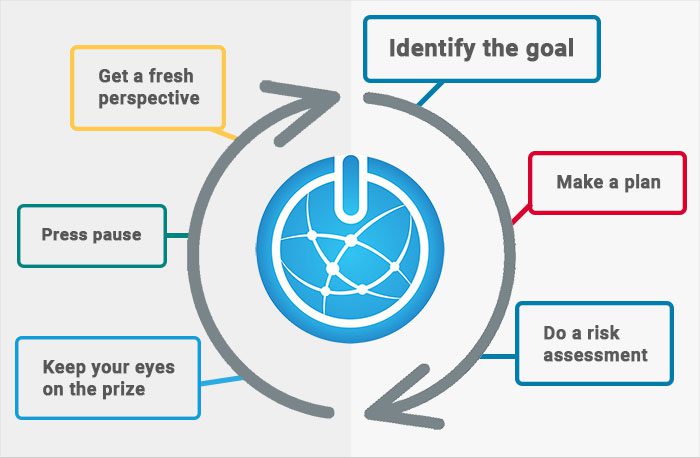What We Do When Things Don't Go As Planned
The best-laid plans of mice and men often go awry... That's true in IT, too. Things don't always go according to plan. Hardware should break in a straightforward way, and therefore, be fixed equally simply, right? Um, no. Anybody working in IT knows that's not always the case. Obstacles come up, and the original plan doesn't work how it's supposed to — it's in those moments when it really counts that you discover the measure of the people you are working with.
How do we deliver on our promises?
We make a lot of claims on our website — about our excellent service, dedication to open communication, and commitment to following through on our promises.
We thought it might be useful to put our money where our mouth is and give a sneak peek behind the curtain into how we deliver on those promises when obstacles come up.

How We Handle Difficult Situations
Sometimes, things don't go the way we expect or break the way they should. But that's ok — we're ready for the unexpected! While this approach is something we implement in our troubleshooting process, it also has broader applications for tackling difficult situations and problems in life (those of us with social anxiety have used a form of it with great success when faced with daunting social situations.)
Identify The Goal: What Are We Trying To Do?
Sometimes, the goal is targeted and obvious — such as replacing a failed drive. But other times, it might be more broad, such as getting a system operational. While it might seem like both of those goals are the same, the implementation and execution of a plan of action might look different. That's why identifying the goal before making the plan creates a more targeted approach.
Strategic Execution: Make A Plan
There may be areas of life where winging it is just fine — but this isn't one of them! Much like the adage of the 7 P's (proper planning & preparation prevents piss poor performance), we are big fans of making a plan. Developing a plan that centers around accomplishing the goal(s) saves a ton of time in the execution phase. It helps us create estimated timelines, allocate resources, and prevent disasters (let's all say no to data loss).
How We Get Started Creating A Plan
Sometimes, getting started with a plan for a more extensive project can be a little daunting. We have a few things we like to do that help get the wheels turning. We often start by documenting everything we know about the project and making lists of what needs to be verified (such as part numbers, availability of resources, and anything else that should be confirmed before work begins). Depending on the situation, it could become a simple outline or more detailed and complex.
On particularly complicated projects, we might pretend we are writing instructions for someone new to the project (anyone remember writing instructions in elementary school for how to tie your shoes or making a peanut butter sandwich?) That's where we can find little knowledge gaps or assumptions that could complicate things down the road. For example, an unknown configuration abnormality could complicate a simple replacement.

Other elements of our plan might include the following:
- Parts & Logistics - identify parts & shipping, if applicable
- System Preparation - check that the system is prepared for service
- Engineer & Field Resources - assign and schedule resources to get the humans where they need to be when
- Approximate Timelines - estimate the time to complete
- Site-specific Guidelines - confirm details such as security, availability, or staff resources
Risk Assessment: What's The Worst Case Scenario?
What's the worst that could happen? This is an important question to consider before beginning to execute the plan. Testing the strategy against the worst-case scenario reveals steps we don't want to take.
Risk assessment can spark the next step because knowing what we don't want to do eliminates possibilities and narrows the path of options moving forward. For instance, if the work could bring the whole system down, causing delays and other issues, a thorough risk assessment is a helpful guide. Averting disaster before it happens? Yes, please.

Stick to the Plan: Keep Your Eyes On the Prize

The plan we've just created acts as a map to help us know where we are headed and what we'll need to get there. Veering off the trail increases the risk of getting lost and doing circles to find the way back.
Let's say we're replacing a 3PAR node, and during the 20 minutes we're waiting for the node to come online, it might be tempting to look at this "new" problem of the LED that's now flashing and chase down the cause. But by staying the course (and with the expert knowledge of our SME), we know that the LED will resolve itself when the node is finished coming online. This sort of thing happens often - usually, we'll finish resolving the issue before starting a new one.
There are times, however, when the opposite is true, and we need to fix unplanned issues before moving forward. For example, let's say we're working on an installation project, and we discover multiple failed parts and no spares on site to deal with them immediately. That's a situation where we would fix the new issues as part of the installation project.
The key to this step is evaluating new information as it comes up for relevance against the original goal — does it serve the goal and/or further it, or does it take me off course? If it is necessary or beneficial to the completion of the original goal, it's worth it to include it; if not, we stay the course, finish and then follow up with a new goal/plan. Each situation is unique and requires critical thinking and the flexibility to pivot when necessary. The broader the goal, the more likely new information and unexpected issues may lead to revising the plan to include them.
Press Pause: Don't Continue Without Purpose
Knowing when it's time to hit the pause button on a project is critical. If things aren't working as expected, it's easy to get overwhelmed by the possibilities and either feel stuck or waste time chasing unrelated problems. If the plan has run its course and hit a dead end, it's time to stop, check in with your goals, and reassess.
Maybe the next step comes into play (getting a colleague's fresh perspective), or it might be obvious that it's time to identify a new goal and create a new plan. Either way, often, the best course of action (that results in the quickest resolution) is to stop, take a step back, and give space to think.

For example, what looks like a simple hard drive replacement could get a little more complicated. After replacing the drive multiple times, it's still not fixing the problem. Time to take a step back and think about what else might be causing the issue. Aha — the drive slot is broken. Continuing to do the same thing with no result isn't helpful and won't lead to a resolution. Now, we can fix the drive slot and get the issue cleared up.
Get A Fresh Perspective: A Second Set of Eyes

Getting another set of eyes on the problem can be a helpful way to break through it. Tunnel vision can happen to the best of us, especially if we've been hyper-focusing on a bunch of details inside a problem.
It's like if you became hyper-focused on removing a bolt — coming up with complex solutions involving rubber bands, chewing gum, hairspray, and complicated algorithms (Macgyver's got nothing on you!) Someone comes along with fresh eyes and says, "Hey, how about trying a wrench??"
That might be a bit of an exaggeration and a "duh" moment, but collaborative teamwork can be a powerful thing. When everyone works together, bringing perspectives, knowledge, and skill sets to the table, problems get solved and stuff gets done.
Sometimes, this step (or the one before) could lead to reassessing the goal, and the process could start again. While this method for dealing with difficult situations is thorough, it doesn't mean that it must be time-consuming. In fact, taking the time to think strategically on the front end allows for quicker and more seamless resolutions.
Let M Global Help
When things get difficult, we've got you covered!
When things don't go according to plan — there's no need to worry! We've got a backup plan for the backup plan! We're all about turning challenges into successes and obstacles into an opportunity for growth. We love creating solutions for our clients, no matter how difficult the challenge.
We want you to consider us an extension of your team, a trusted resource and an advisor. Fill out the form or give us a call at 855-304-4600 to find out more.
Got an IT Nightmare? Let Us Help.
Suggested Content






